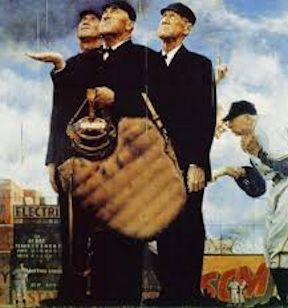 Pregame Umpire Meeting
Pregame Umpire Meeting
Pregame communication with your partner (or partners) begins even before you arrive at the field.
NOTE: We provide a downloadable PDF version of the checklist that you can print out and carry.
Prior to the game and arriving at the field
- Either by email or by phone, connect with your partner one or two days in advance of the game. Confirm game time, field, parking location, and colors. If your association does not assign slots, arrange who takes the plate and base slots. Arrange to park together so you can conduct your pregame meeting while preparing for the game. Agree on colors (by tradition, the plate umpire calls the shirt color).
- Arrive at the field at least 30 minutes before game time. It's recommended that you arrive an hour before game time.
- Check in with tournament director, coaches, or athletic director to ensure that the person in charge of the game is aware
that you have arrived. In tournaments there is either a tournament director or a tournament umpire coordinator. - Check the condition of the field if weather is a factor to ensure playability. If there are issues, discuss this with the person in charge (likely a coach or athletic director). Once you have exchanged lineups at the plate meeting, however, the game belongs to you and you are the sole judge of the playability of the field.
Pregame meeting with your partner
You pregame meeting with your partner should cover most, if not all, of the following points. The plate umpire typically drives the plate meeting.
- Catch/no-catch coverage & "going out". Go over your catch/no-catch coverage scenarios – that is, with U1 in A versus U1 in B or C. Discuss U1 going out from A. For detailed information, see Catch/No Catch and Going Out.
- Fair/foul coverage. U1 has fair/foul coverage only from A, from the leading edge of the bag and beyond. However, some fields do not have adequate foul lines out to the pole, so it may make more sense for PU to take all fair/foul. Be sure to cover this.
- Signals & eye contact. Cover the umpire-to-umpire signals you'll be using through the game to ensure you're all on the same page. PU initiates signals and base umpire returns the signal to ensure you're both in sync. For more information, see Umpire Signs & Signals.
- Checked swings. Discuss handling checked swings (give me what you have). Cover handling RH batters when U1 is in C.
- First-to-third rotation. With R1, or R1 and R3, you're in the first-to-third rotation, so on batted balls to the outfield, PU has R1 going into 3rd, if he goes. Be sure you're on the same page about this, and that you're in sync on the signal (PU points to 3rd).
- Touches and tags at 3rd (with runners on). With runners on, PU has all touches and tag-ups at 3rd base.
- PU rotations. Cover PU rotations -- that is, when he goes up to third, and when staying home, and signals for each.
- U1 going out. Discuss U1 going out from A, and that PU then has BR "all the way."
- Covering rundowns. Discuss covering rundowns. When and how does partner join a rundown. When should U1 stay with a trailing runner instead of joining rundown. There is more information in the article Covering Rundowns.
- Calling balks. Discuss level-appropriate approach to seeing and calling balks. Ensure you're both using the same rules (i.e., FED vs. OBR) for balks.
- Foul ball off batter (in the box). Technically PU's call, but often seen more easily by U1. Discuss "see it, call it."
- Overthrows out of play. Technically PU's call, but either umpire can call it. Discuss "see it, call it."
- Running lane interference. Again, the PU owns this call; however, especially with R3, U1 might grab the call. Cover communicating that "I've got this one."
- Force-play slide/illegal slide/interference. Discuss the force-play slide rule for your league (this rule varies) and emphasize that PU needs to have eyes on runner going into 2nd base when there's a double-play in progress.
- Swipe tag/pulled foot at 1st. Discuss PU trailing batter-runner (unless runner in scoring position), or watching from 1st base line extended (1BX) to help with swipe tag and pulled foot at first base.
- Touches, tags, appeals. Discuss who owns touches and tags at the bases in all scenarios. The owner of a given base also owns appeals at that base. While U1 typically own all runners at all bases, there are situations where the PU has 3rd base, or, if U1 goes out, PU has the
batter-runner all the way. - Getting the call right. Discuss your mechanics for getting together if you have a questionable call or a coach's appeal of an error in the application of a rule. Never conference on judgment calls unless you're pretty sure you screwed up and want some cover to reverse the call.
- "I have information for you". Occasionally you will see something on partner's call that might help him on a disputed or controversial call. If so, never intrude on your partner's handling of the call. However, you can have a prearranged signal to indicate (subtly) that you've seen something he might like to hear about. If you make eye contact, flash the signal and then your partner can decide whether to
conference with you. - Inspecting equipment (Little League only). Little League requires that umpires inspect bats and helmets to ensure they are rules compliant. Discuss to ensure that you understand the bat regulations for the game's age level.

